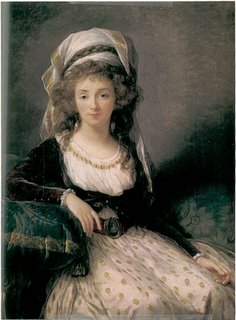
I have read with great interest my hostess’ recent missives on the life of a lady-in-waiting. (I have also been watching with equal interest the little irridescent circlets on the d-v-d machine while Miss McCabe is at what she calls her “job,” though I see little sign of something respectable like governessing. Some of these circlets purport to be living versions of Miss Austen’s delightful novels. I have much to say about them, though I will reserve commentary for a future letter). This missive concerns my own youthful days at Court, before I married my dear, departed husband. There is much time to muse on those delightful days now, as I still am residing in Miss McCabe’s rather untidy cottage. When she is gone, I cannot operate the rather mysterious contraptions here (and she became rather cross when I broke the whirling blades of the, um, blender. I only wanted one of those delightful fruit concoctions called smoothy-s, which are much like some of the sweets at Gunters, near where I once lived. Ah, but that is another tale. Anyway, how was I to know one must first remove pits from peaches?). Fortunately, there are many books to read (though some are quite shocking! Have you read a tome called “Dedication” by Miss Mullany?), and I have my memories to keep me company until I can discover the means to return to my own home.
When I was a young lady, my parents sent me to Court to serve as a maid-of-honor to dear Queen Charlotte (a most dignified and morally correct lady, no matter what might be said about her in less dignified circles. The young ladies in this incomprehensible twenty-first century could learn a great deal from Her Majesty’s sterling example. Why, my hostess actually goes about with men without a chaperone! But the less said about that…) My time at Court proved to be excellent preparation for my future life.
A typical day at my duties would run thus: I would rise at about six, and be summoned to the Queen’s dressing room at half past seven. The wardrobe women would already have completed the preliminary stages of Her Majesty’s toilette, and we would help her with the finishing touches. I would then return to my room for breakfast, attend to my correspondence, and perhaps take a short walk before attending to the Queen’s midday change of gown. This would often take two or three hours, leaving only a brief time before attending the Queen on her evening preparations and whatever events were scheduled for that night (a ball or concert, perhaps).
It is true that the hours were long and the rules many, and a few of my fellow Maids (whining wretches!) had little good to say about the great honor bestowed on them. Yet I met my dear husband at Court, and learned a great deal about honor and propriety which Certain People would do well to follow.
Now, I must go, for I hear my hostess’ strange horseless phaeton entering the strange stable she calls a garage. I have to ask her again how one operates the intriguing gadget that pours out coffee in such a neat little stream…
